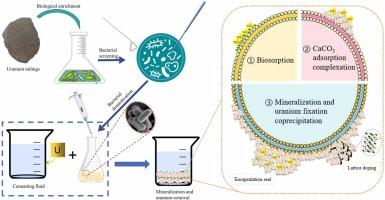尾矿库原生细菌对铀污染水体的修复及矿化沉淀机理研究
IF 7.8
2区 环境科学与生态学
Q1 ENGINEERING, CHEMICAL
引用次数: 0
摘要
针对铀尾矿库地区铀污染水体的修复需求,系统探索了基于微生物诱导碳酸盐沉淀(MICP)技术的生物矿化固铀去除机理。以香港孢子孢菌(Sporosarcina sp., HK-1)为研究对象,探讨了HK-1提高除铀效率的机制和协同固铀途径。结果表明,驯化后铀的生物去除率和矿化率分别提高到44.03 %和58.68 %。采用响应面法对培养参数进行优化后,固铀共沉淀产物可达到高效除铀效果,并可通过晶格取代和包封提高固化稳定性。铀胁迫下的矿化动力学分析表明,驯化菌株的铀固定效率进一步提高至86.14 %,共沉淀产物中铀的二次释放率显著降低。微观表征揭示了其作用机制:1)细菌对官能团的生物吸附;2)碳酸盐矿物的界面配位与络合作用;3) UO₂2+通过晶格支撑共沉淀转化。MICP技术通过定向形成铀-碳酸钙复合矿物,显著抑制了铀的溶解和迁移,从而增强了铀的稳定性。本文章由计算机程序翻译,如有差异,请以英文原文为准。

Study on the remediation of uranium contaminated water by indigenous bacteria in tailing pond and the mechanism of mineralization and precipitation
To address the remediation demand of uranium-contaminated water in the uranium tailings pond area, the removal mechanism of biomineralisation uranium fixation based on microbial-induced carbonate precipitation (MICP) technology was systematically explored. The mechanism of enhancing uranium removal efficiency and the synergistic uranium fixation pathway of HK-1 was elucidated using the selected indigenous Sporosarcina sp. strain (HK-1). The results showed that the biological removal rate and mineralization rate of uranium after domestication increased to 44.03 % and 58.68 %, respectively. After optimising the culture parameters using response surface methodology, the high-efficiency uranium removal effect of uranium-fixation coprecipitation products could be achieved, and the solidification stability could be enhanced through lattice substitution and encapsulation. The mineralisation kinetics analysis under uranium stress revealed that the uranium fixation efficiency of domesticated strains was further enhanced to 86.14 %, and the secondary release rate of uranium in coprecipitation products was significantly reduced. Microscopic characterization revealed the mechanism of action: 1) biosorption of functional groups of bacteria; 2) Interfacial coordination and complexation of carbonate minerals; 3) UO₂2+ is transformed by lattice-supported coprecipitation. Through the directional formation of uranium-calcium carbonate composite minerals, MICP technology significantly inhibits the dissolution and migration of uranium, thereby enhancing its stability.
求助全文
通过发布文献求助,成功后即可免费获取论文全文。
去求助
来源期刊

Process Safety and Environmental Protection
环境科学-工程:化工
CiteScore
11.40
自引率
15.40%
发文量
929
审稿时长
8.0 months
期刊介绍:
The Process Safety and Environmental Protection (PSEP) journal is a leading international publication that focuses on the publication of high-quality, original research papers in the field of engineering, specifically those related to the safety of industrial processes and environmental protection. The journal encourages submissions that present new developments in safety and environmental aspects, particularly those that show how research findings can be applied in process engineering design and practice.
PSEP is particularly interested in research that brings fresh perspectives to established engineering principles, identifies unsolved problems, or suggests directions for future research. The journal also values contributions that push the boundaries of traditional engineering and welcomes multidisciplinary papers.
PSEP's articles are abstracted and indexed by a range of databases and services, which helps to ensure that the journal's research is accessible and recognized in the academic and professional communities. These databases include ANTE, Chemical Abstracts, Chemical Hazards in Industry, Current Contents, Elsevier Engineering Information database, Pascal Francis, Web of Science, Scopus, Engineering Information Database EnCompass LIT (Elsevier), and INSPEC. This wide coverage facilitates the dissemination of the journal's content to a global audience interested in process safety and environmental engineering.
 求助内容:
求助内容: 应助结果提醒方式:
应助结果提醒方式:


